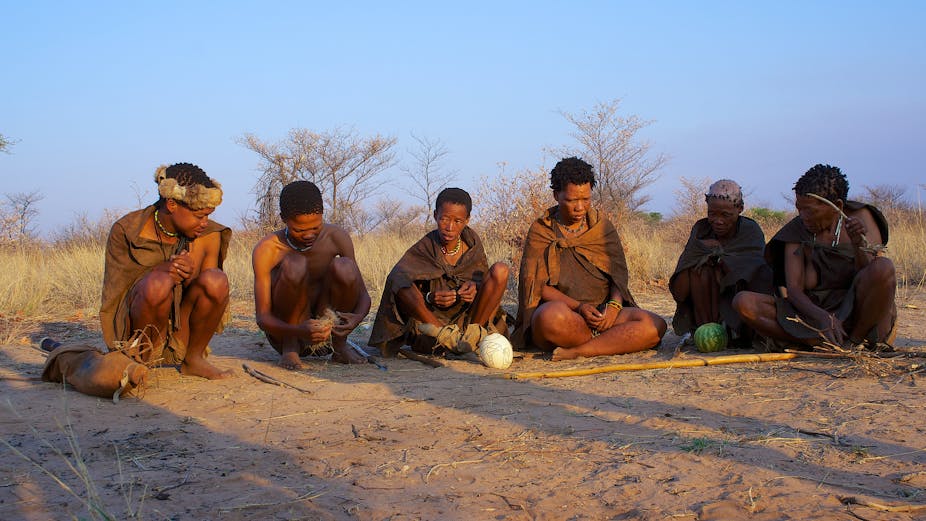On paper, Botswana is a multilingual state with at least 25 languages spoken within its cities, towns and villages. In reality, Setswana dominates. It is the national language, spoken by the vast majority of the population as either a mother tongue or second language.
Setswana is the medium of instruction during the first two years at primary school. It is offered as a compulsory school subject for the rest of primary school and throughout secondary school. English is the medium of instruction for all subjects at primary and secondary school levels except for Setswana as a subject. Minority languages do not feature. This focus on only two languages in the education system is seen by language activists as a barrier to the transmission of ethnic minority cultures and appreciation of diversity.
Botswana battles with issues of ethnicity. Schools can find themselves on the front line of this tension if teachers aren’t equipped with the skills and knowledge that would enable them to embrace multiculturalism – whether linguistic, cultural or social – in their classrooms.
I set out to establish whether being trained specifically in how to deal with multiculturalism could empower teachers. The results suggest that the answer is, unequivocally, “yes”.
Culture and power
Primary school children who belong to ethnic minorities are especially vulnerable to dropping out of school early. Research has shown that one of the driving factors here is the insensitivity of schools’ culture and curriculum to their culture and learning styles.
Culture and learning can’t be separated. Psychologist Jerome Bruner has pointed out that
… education does not stand alone, and it cannot be designed as if it did. It exists in a culture. And culture whatever else it is, is also about power, distinctions, and rewards.
The teachers who took part in my research were already working. They served at schools in remote areas and many of their students belonged to ethnic minorities. They enrolled for the University of Botswana’s B.Ed Secondary Programme, where they studied two of the courses I taught: Foundations of Multicultural Literacy Education and Literacy, Education and Culture.
These courses were only introduced at the university in the 2001/2002 academic year, so none of the research participants – who had been working for some years – were exposed to this kind of thinking when they first trained as teachers between a decade and 15 years earlier.
The participants were selected because they felt that these multicultural education courses had helped them to reflect on their own biases towards ethnic minority groups. The participants were monolingual: they came from the dominant mainstream Setswana speaking groups. All of them told me that their initial qualifications had really only prepared them to teach homogeneous classes comprised of students from common cultural backgrounds.
For their fourth year research project, the participants conducted research about how issues of multiculturalism were dealt with in their schools. Their work revealed an almost total disregard for minority cultures and languages.
Language and exclusion
One participant said she was disappointed by her colleagues’ lack of enthusiasm for teaching pupils about culture. She said:
Many schools across the country have built traditional huts called cultural villages where traditional artefacts and resources are stored. These resources are meant to be used by teachers to enrich the teaching and learning of topics on culture yet people do not take the teaching of culture seriously.
Part of the problem seems to be that cultural topics don’t feature in final year examinations. Cultural issues also aren’t considered important in Botswana’s broader society.
Another participant researched the curriculum and found that it wasn’t inclusive of minority cultures. This was particularly true when it came to language. She wrote:
Setswana lessons could be perceived as “prisons” where students are captives and deprived of expressing themselves in their mother tongue.
Other teachers I spoke to beyond the core research group concurred. They attributed San students’ high failure and drop out rates to Botswana’s existing language in education policy.
Seeking solutions
My findings suggest that Botswana’s teachers definitely need more specialised training in multiculturalism. The country’s teacher education institutions must develop and offer such courses to both pre-service and in-service teachers. Refresher courses should also be offered to serving teachers who were never exposed to multicultural education during their initial training.
Formal training alone will not fix the problem. Individual teachers must engage in critical self-examination that explores their attitudes and perceptions concerning cultural diversity. They need to be aware of how these can effect their students’ achievements and educational opportunities.
Teachers should also go in search of accurate information about various culturally diverse groups’ histories, cultural styles and values. This will help them understand and engage with students from these groups. It will also enable them to share this knowledge with other students and so encourage multicultural understanding.
These multicultural perspectives should be infused into teaching materials and, ultimately, the country’s curriculum. In this way, schools can maximise their students’ academic, cognitive, social, psychological and cultural development.

